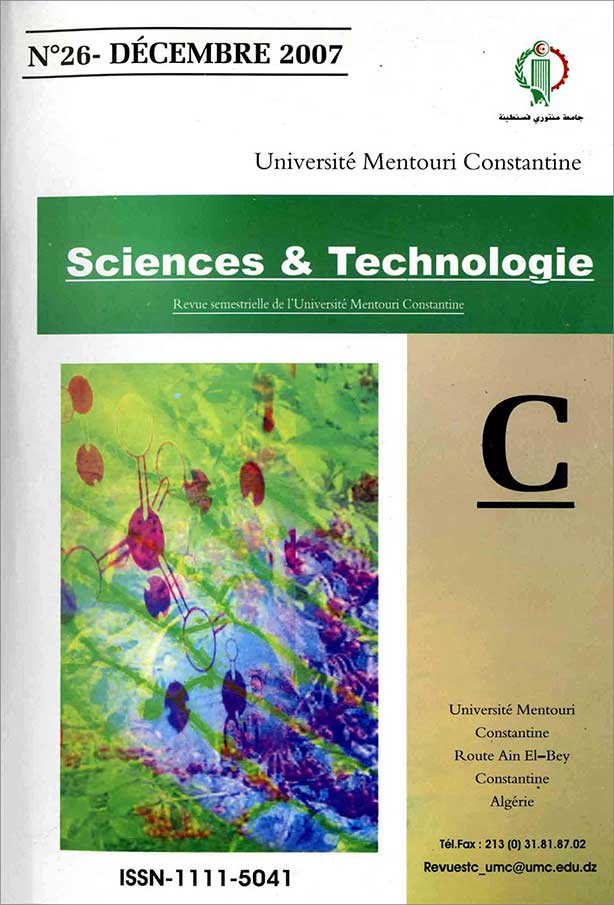EVALUATION DE L’ACTIVITE CICATRISANTE D’UN ONGUENT TRADITIONNEL DE LA REGION DE CONSTANTINE SUR LES PLAIES D’EXCISION CHEZ LE RAT
Mots-clés :
Scars, Traditionnal onguent, Wounds, cicatrisation, onguent traditionnel, plaiesRésumé
The scar process is a biological phenomenon which is automatically and immediately put to action by the organism as soon as there is a physical damage of some tissue except nervous cells. Many scarring products whose efficacity is well known, but there are sometimes some therapeutics failures. We have tried to evaluate scarring properties of a traditionnal onguent used in Constantine region, on excision wounds inrats. The study has been carried out on three groups of rats separately. The first one is treated (RTT) with the tested onguent, the second one will have no treatment and will serve as a negative witness (RT-), and
the third one will receive a daily officinal vaseline application and will represent the positive witness (RT+) . The evaluation of scars is done by a planimetric study. Mensurations are done every three days during a period of fifteen (15) days. The traditionnal onguent has shown a positive action on scars with a very important concentration, and which become quicker between the 6th and the 12th day, to reach 93.7%
of the initial surface on the 15th day for the part treated; against 84% and 85% respectively for positive and negative witness parts.
It seems then, that the traditionnal onguent has an evident scarring activity that has a close link with its well known efficacity in popular medicine of its original region.
Références
-ABRENHAUS, JJ. “ Collagen shits as a dressing for large excised areas ”. Surg. Forum., 1965, 16, 477-478.
-ABERCOMBIE, M. JAMES , DW. NEWCOMBE, JF. “ The role of contraction in the repair of excised wound of skin ”; In wound heal inf. Ed. Pergamon press London., 1961, 207-222.
-ANDERSON, D. “ wound management in small animal practice ”; In practice, march1996, 115-128.
-ARCHIBALD, J. “ La cicatrisation. Traumatologie canine ” Ed. l’expansion scientifique Paris,1976, 5-16.
-BALLER, MS. AIKEN, S. “ The healing of open wounds ”, Seminars in veterinary medicine and surgery, 1989, 4, 268-276.
-BERNOLIN, B. “ Le collagène: activité hémostatique et cicatrisante ”, Th. Doct. Vet. Lyon, 1985.
-BERTHE, T. “ Contribution à l’étude du traitement des plaies à l’aide d’un hydrogel d’amidon ”Th. Doct. Vet. Toulouse, 1983.
-BILLINGHAM, R.E. MEDAWAR, P.B. “ Contractive and intissuceptive growth in healing of extensive wounds in mammalian skin . ” J. Anat., 1959, 89-114.
-CARLIER, A. “ Contribution à l’étude de la cicatrisation des plaies, action d’un extrait placentaire. ” Th. Doct. Vet. Lyon, 1980.
-CLARE, R.G. “ Wounds healing and influencing factors ”. Manual of canine and feline wound management and reconstruction. Ed. Fowler Canada, 1999, 15-23.
-DISS, N. “ La cicatrisation et ses complications. Chirurgie plastique et reconstructrice ”.Unité de pathologie de chirurgie ENVLyon, 11-14.
-FAYOLLE, P. “ Cicatrisation des plaies cutanées ” . Le point vétérinaire, 1992, 24, 409-422.
-JOHN, M.W. “ Open wound management ”. Manual of canine and feline wound management and reconstruction. Ed. Fowler Canada, 1999, 37-39.
-JOHNSTON, DE. “ The process in wound healing in the horse. The role ofwound contraction. Equine Vet. J., 1972, 4, 93-97.
-LORENZETTI, OJ. “ Influence of microcristaline collagen on wound healing ”, Proc. Soc. Exp. Biol. Med., 1972, 140, 896-906.
-MILNE, DW. “ Wound healing and management ”. Proceedings of the 24th annual convention of the Am. Ass. of equine practionners Missouri, 1979, 343-349.
-MOORE, AO. SMITH, LA. CAMPBELL, F. SEERS, K. Mc QUAY, HJ. MOORE, RA. “ Systematic review of the use of the honey as a wound dressing ”. Complementary and alternative medicine, 2001, 1:2, 1-6.
- MORTON, JJP. MALONE, MH. “ Evaluation of vulnerary activity by an open wound procedure in rats ”. Arch. Int. Pharmacodyn. 1972, 196, 117-126.
-NAYAK, S. NALABOTHU, P. SANDIFORD, S. HOGADI, V. ADOGNA, A. “ Evaluation of wound healing activity of Allamanda
cathaiticaand Lorus mobilis extracts on rats ”. Complementary and alternative medicine, 2006, 6:12, 1-6.
-PADRAS, A.M. “ The evaluation of collagen film applied to skin defects in mice ”. Surg. Forum. 1959, 10, 844-846.
-PERRON-LEPAGE, M.F. “ La cicatrisation des plaies cutanées ”. Prat. Vet. Equine, 2000, 32, [126], 7-13.
- SALMON, H. “ La cicatrisation des plaies cutanées : action de la levure Metschnikowia pulcherima ”. Th. Doct. Vet. Alfort, 1970.
-SILVER, A. “ Basic physiology of wound healing in the horse ”. Equine Vet. J., 1982, 14, [1], 7-15.
-SWAIM, SF. LEE, AH. “ Topical wound medication. A review ”. J.A.V.M.A, 1987, 190, [12], 1580-1593.
-SWAIM, SF. “ Wound dressing materials and topical medication. Small animal wound management. ” 2nd Ed; Williams and Wilkins Ed. , Baltimore [USA], 84-85.
-SWAIM, SF. “ Trauma to the skin and subcutaneous tissue of dogs and cats veterinary clinics of North America ”. Small Animal Practice, 1980, 10, [3], 599-618.
-WALTON, G.S. NEAL, P.A. “ Observations on wound healing in the horse. The role of wound contraction. ” Equine Vet. J., 1972, 4, [2], 93-97.

